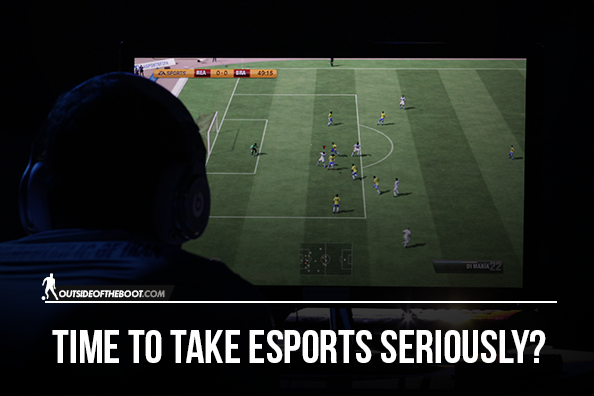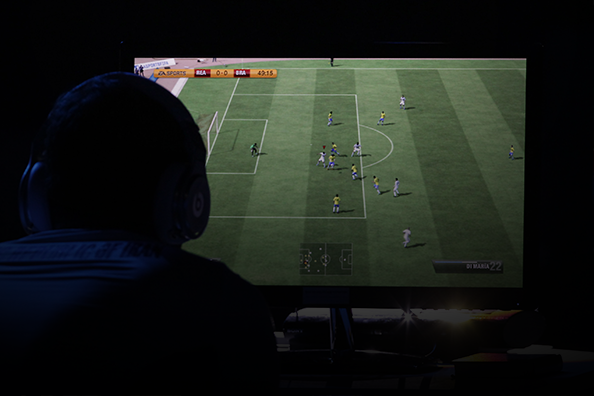Terry Hearn writes about the rapidly growing spectacle that is eSports.
For many people, the mention of the phrase eSports conjures images of teenage boys gathering in a basement for a weekend-long online Warcraft session. Even events such as the League of Legends World Championships in China, which offer millions in prize money, are easy to dismiss as an extreme exception to the rule – these are not events for the general public.  But with BT Sport, one of the UK’s dominant sports broadcasters, announcing plans to broadcast FIFA eSports events in 2017, it seems that eSports are rapidly heading towards mainstream awareness. With club sponsorship, increasing prize money and FIFA recognized competitions, there is no doubt that the football establishment in Europe is behind this evolution, but how will this enthusiasm translate to the typical fan? Will people who are not invested watch other people play games, and why would those who do play choose to watch others, rather than play themselves? For most it will be experience and level of play and skill, for some it will be slow internet speeds and the location in which they live. Perhaps you’re wanting to upgrade to a faster internet provider, looking on sites such as usave broadband to compare providers can be a great help to saving money.
But with BT Sport, one of the UK’s dominant sports broadcasters, announcing plans to broadcast FIFA eSports events in 2017, it seems that eSports are rapidly heading towards mainstream awareness. With club sponsorship, increasing prize money and FIFA recognized competitions, there is no doubt that the football establishment in Europe is behind this evolution, but how will this enthusiasm translate to the typical fan? Will people who are not invested watch other people play games, and why would those who do play choose to watch others, rather than play themselves? For most it will be experience and level of play and skill, for some it will be slow internet speeds and the location in which they live. Perhaps you’re wanting to upgrade to a faster internet provider, looking on sites such as usave broadband to compare providers can be a great help to saving money.
There is a market for it
A Viacom study of young adults in the UK discovered that 87% of young people (aged 13-30) play video games, and it is not just teenagers. The data revealed that those children who grew up with a Super Nintendo in the 1980s have not relinquished their hobby and continue to play games into their 30s, creating a broad base of experienced gamers. As millennials have become accustomed to consuming media content on the go, watching game walkthroughs on YouTube has become the modern equivalent of the Nintendo tips hotline – the go-to resource for gamers stuck at a certain point of their games. Between the rise of internet personalities and the evolution of consoles, the idea of broadcasting live gameplay has not just become appealing and simple, but standard as apps such as Twitch allow any player to broadcast their games live. The result of this normalization is clear as 49% of those polled had heard of eSports and more than one in ten already access eSports content at least once per week. Evidently, in the casual gaming community, there is little stigma towards watching others play.
One game to rule them all
League of Legends is one of the most popular eSports games because, in it, you’re always trying to increase your skills in the vast world the game has. A Multiplayer game, League of Legend also known as LoL, allows players to continue progressing and working on their skills when it comes to competitive gaming. Those who wish to take part in competitive gaming can use either their own accounts or create new lol accounts in order to improve their skills. Similarly, Minecraft is another example of a video game that often makes headlines. Although games like Minecraft do have multiplayer mode, this type of gaming currently requires the assistance of minecraft server hosting providers. However, while lagging behind games like Minecraft and League of Legends in terms of audience, EA Sports’ FIFA series is the most likely online game to achieve mainstream crossover because it speaks the universal language of sport. It also helps that it is one of the most successful franchises in gaming, having sold over 150 million copies worldwide. For many people across the world, the word FIFA is more synonymous with video games than football’s own governing body, from which the series takes its name. Launch weekend in the UK saw sales of FIFA 17 up 18% over the previous year’s iteration, making it the most successful launch for any game in the series’ 24-year history. With a focus on realism, FIFA’s licensed players, clubs and stadiums strive to close the gap between a game and reality. This offers instant accessibility to casual sports fans to watch a game, just as they would a real match. And it works – they will give the same excited reaction when Ronaldo fires a late winner into the in off the goalpost as they would in a real match. This accessibility was demonstrated in a 2014 poll which revealed that 34% of Americans began following football after playing the game, widening the interest and reach of football across the world. Just as the video game has brought interest and an increased following to the actual sport, so, it seems, the reverse could be true as professional clubs including Manchester City, PSG, Monaco and Roma have all agreed sponsorship deals with eSports players, meaning that these players will wear those clubs’ respective colours, effectively representing them at competitions. Between the game’s official licensing, the support of clubs and broadcasting on sports channels, FIFA has a great chance to crossover and attract a sizeable television audience simply by treating eSports with a level of respect it has yet to collect outside the gaming community.
Treated with respect
Gaming on television has always been a rocky road. Channel 4’s GamesMaster presented competitive gaming in the 90s with some success, before the novelty wore away. Similarly, a modern take, Dara O Briain’s Go 8 Bit, sees celebrities compete over a series of games from across the years. These formats present gaming more as a quirky pastime rather than a serious competitive event, quickly alienating casual viewers and serious gamers alike. By broadcasting an eSports competition in the same way as a sporting event rather than as a game show, it has the potential to be taken as seriously as real, albeit niche, sports. With it not unusual for the Premier League’s best player to earn £100,000 per week and BT Sport paying almost £1.2 billion for three years’ Champions League and Europa League coverage, Football is increasingly built on big money and so expanding the brand by pushing eSports makes a lot of sense to the organisations involved. As well as exposing regular sports fans to eSports, it has the potential to bring in an audience of millennials who are moving away from watching shows through traditional mediums, and might be less than inclined to regularly watch sports channels. However, finding out whether eSports can seize this opportunity and turn the initial curiosity of these two groups into a sustained audience, remains to be seen.





















































